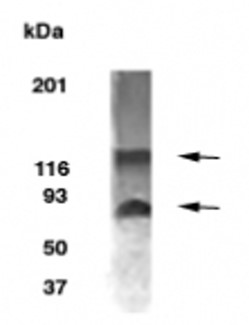Anti-BCAS1 / NABC1 Antibody (34017)
$400.00
SKU: 34017
Categories: Antibody Products, Cancer Research Antibodies, Products
Overview
Product Name Anti-BCAS1 / NABC1 Antibody (34017)
Description Anti-BCAS1/NABC1 Rabbit Polyclonal Antibody
Target BCAS1 / NABC1
Species Reactivity Human
Applications WB,IHC
Host Rabbit
Clonality Polyclonal
Immunogen Synthetic peptide corresponding to amino acids 532-550 of human BCAS1/NABC1.
Properties
Form Liquid
Concentration Lot Specific
Formulation PBS, pH 7.4.
Buffer Formulation Phosphate Buffered Saline
Buffer pH pH 7.4
Format Purified
Purification Purified by immunoaffinity chromatography
Specificity Information
Specificity This antibody recognizes human BCAS1/NABC1.
Target Name Breast carcinoma-amplified sequence 1
Target ID BCAS1 / NABC1
Uniprot ID O75363
Alternative Names Amplified and overexpressed in breast cancer, Novel amplified in breast cancer 1
Gene Name BCAS1
Sequence Location Cytoplasm
Biological Function Required for myelination. {UniProtKB:Q80YN3}.
Research Areas Cancer research
Background Breast Carcinoma Amplified Sequence 1 (BCAS1), also known as Novel Amplified in Breast Cancer 1 (NABC1) was isolated from a region at 20q13 and is amplified in several tumor types. It is associated with more aggressive tumor phenotypes. BCAS1/NABC1 is highly expressed in some, but not all, breast cancer cell lines and in some breast tumors at 20q13.2. The BCAS1/NABC1 gene is predicted to encode a protein of 584 amino acids with no significant homology to other proteins.
Application Images


Description Immunoblotting : use at 1-5ug/ml. A band of approximately 60 kDa is detected, however, protein dimerization may occur.
Handling
Storage This antibody is stable for at least one (1) year at -20°C. Avoid multiple freeze- thaw cycles.
Dilution Instructions Dilute in PBS or medium that is identical to that used in the assay system.
Application Instructions Immunoblotting : use at 1-5ug/mL.A band of approximately 60kDa is detected, however, protein dimerization may occur.
These are recommended concentrations. User should determine optimal concentrations for their applications.
These are recommended concentrations. User should determine optimal concentrations for their applications.
References & Data Sheet
References Chang, N.S et al. Oncogene (2005) 24: 714-723.
Aqeilan, R.I. et al. Cancer Res (2004) 64: 8256-8261.
Sze, C.I. et al. J Biol Chem (2004) 279: 30498-30506.
Aqeilan, R.I. et al. Cancer Res (2004) 64: 8256-8261.
Sze, C.I. et al. J Biol Chem (2004) 279: 30498-30506.
Data Sheet  Download PDF Data Sheet
Download PDF Data Sheet
 Download PDF Data Sheet
Download PDF Data Sheet


